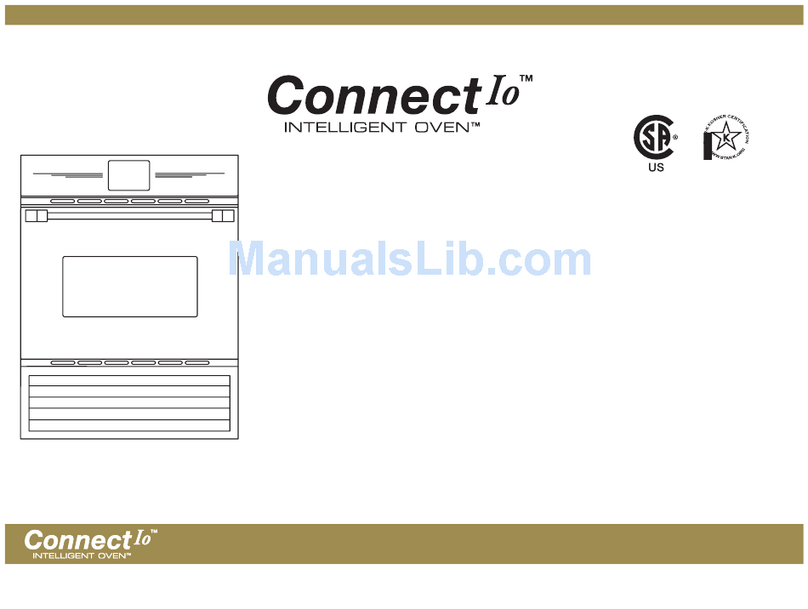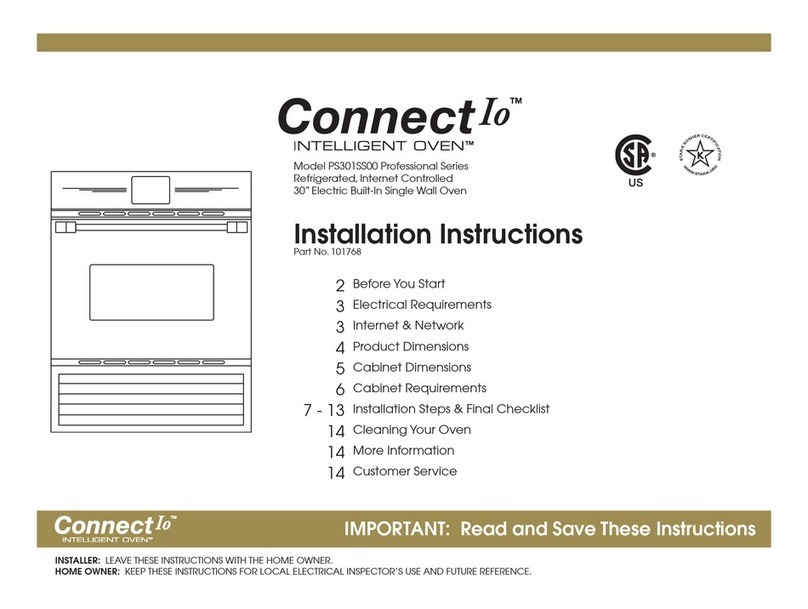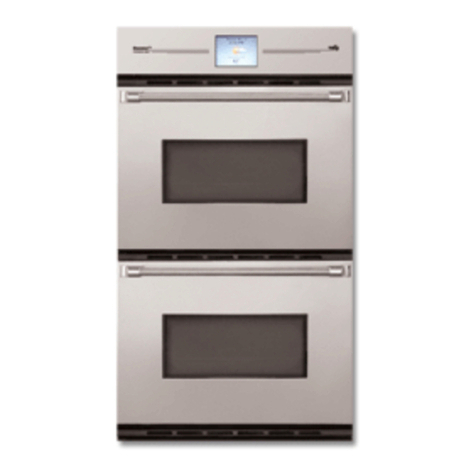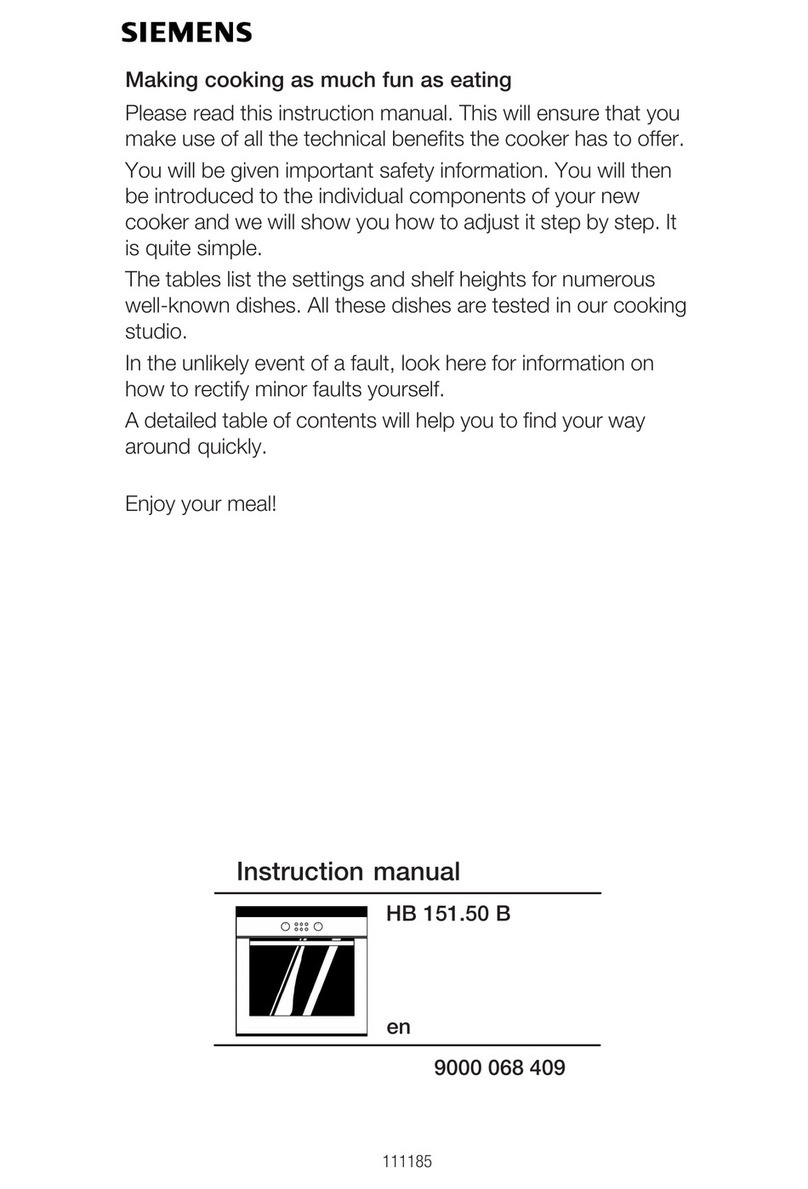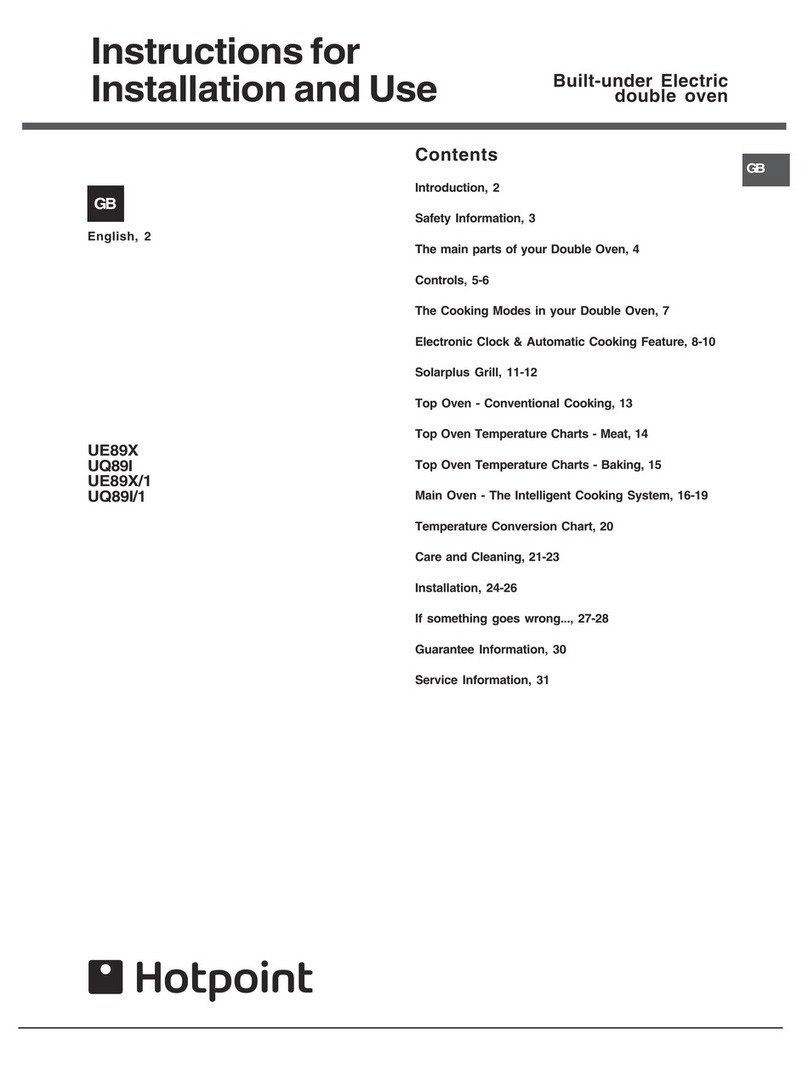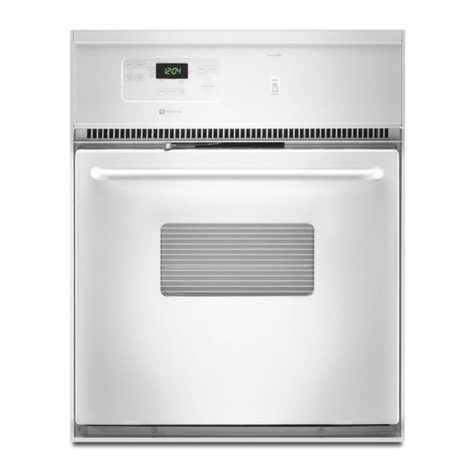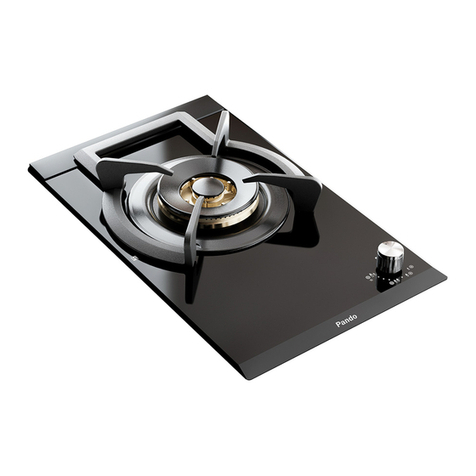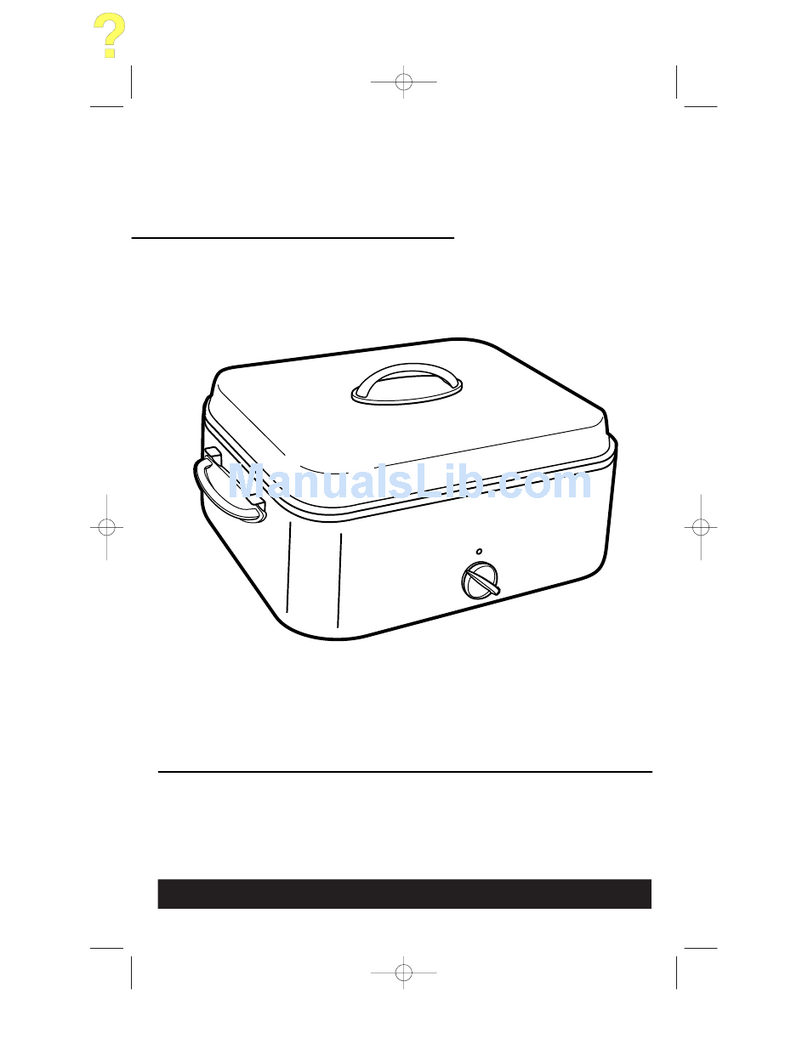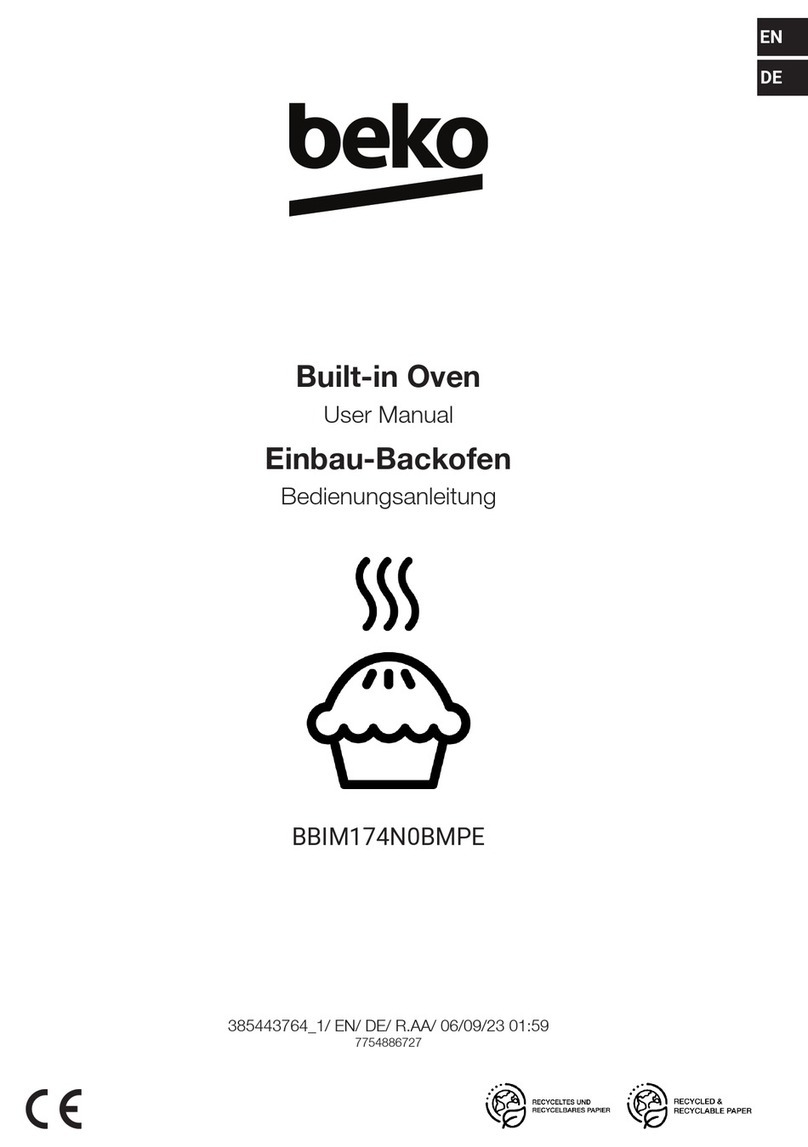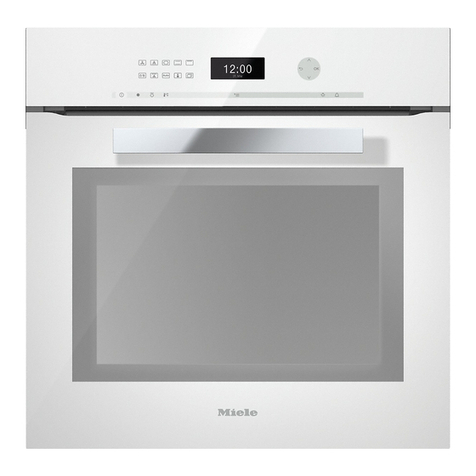TMIO Connect Io PS302SS00 User manual

Installation Instructions
30” Built-In Electric Double Wall Ovens
Model PS302SS00
Quick Reference
before you start 1
2
electrical requirements
internet & network requirements 2
product dimensions 3
cabinet dimensions 4
installation steps 6
final checklist 12
“Pending”
LIMPORTANT: Read and Save These Instructions
INSTALLER: LEAVE THESE INSTRUCTIONS WITH THE HOME OWNER.
HOME OWNER: KEEP THESE INSTRUCTIONS FOR LOCAL ELECTRICAL INSPECTOR’S USE AND FUTURE REFERENCE.
TMIO, LLC INSTALL.REV1B

Before You Start
Please read these instructions completely and carefully:
This is a safety
alert. Always read
and obey all safety
messages. This
symbol warns you of
potential hazards
that can kill or hurt
you and others.
LThis is an
information symbol.
Indicates additional
detailed instructions
are given in this
manual.
You can be seriously
injured if you don’t
follow the instructions
in this manual before
you start.
WARNING
CAUTION: Oven is heavy. Use care in handling. 9
Proper Installation is your responsibility.
Ensure the oven is electrically connected by a
qualified electrical installer and conforms with the
National Electrical Code, ANSI/NFPA 70 – latest
edition, or in CANADA, Canadian Electrical Code,
CSA C22.1-1982 and C22.2 No. 01982 – latest
edition.
Ensure this oven is properly grounded.
LSee “Electrical Requirements” &“Installation
Steps, Making the Electrical Connection” for details.
Potential fire or burn hazard exists if cabinets
above the oven are used for storage.
9
Electrical Preparation: a 1” diameter hole (or
larger) should be drilled in the top left rear corner of
the oven cabinet and/or sheet rock to enable the
4-wire oven electrical cord to pass through the
cabinet to connect to the household electrical
supply. LSee “Cabinet Dimensions” for details.
Quick Reference:
Required cabinet cutout width of 28 1/2”
(72.4 cm) minimum - 28 3/4” (73 cm)
maximum is needed.
9
Do not use this appliance for space heating.
Required cabinet cutout depth of 24” (61 cm)
is needed.
9
9We HIGHLY RECOMMEND running CAT5 cable
to where the back of the oven will be located.
9Oven support surface should be flat, level and
be able to support a weight greater than 575
pounds (261 kg).
9All governing codes and ordinances must be
observed.
9Do not remove permanently affixed labels,
warnings, or plates from the oven! These are
important for your safety.
9Recessed installation area must provide
complete enclosure around the recessed portion
of the oven.
9Always disconnect the electrical supply to the
oven before servicing. 9Oven location should be away from strong draft
areas (windows/doors) and strong heating vents.
Tools Needed:
Phillips screwdriver
Parts Supplied:
8 mounting screws
1

Electrical Requirements
This oven requires a separate, grounded
4-wire, 240 V (AC), 50 Amp service with its
own circuit breaker.
This unit is equipped with a No.10 ground wire in
the conduit.
9
The electrical conduit must be kept to the top left
for a flush installation. Never cut the conduit.
9
The flexible armored cable should be connected
directly to 4-wire, 240V household service.
9
If codes permit and separate grounding wiring is
used, it is recommended that a qualified
electrician determine the grounding path and
wire gauge is in accordance with local codes.
9
Oven must be connected to the proper
electrical voltage and frequency as specified on
the model/serial rating plate (located on oven front
frame).
9
Wire sizes and connections must conform with
the rating of the appliance and to the requirements
of the National Electrical Code, ANSI/NFPA 70 –
latest edition, or Canadian Electrical Code, C22.1-
1982 and C22.2 No. 01982 – latest edition, and all
local codes and ordinances.
9
•Maximum Amp Usage, 46.7A
•Preheat Rating, 5300 W
•Broil Element Rating, 3300 W
•Baking Element Rating, 2000W
• Convect Cook Element Rating,
1650W
Electrical
SPECIFICATIONS:
Junction boxes installed on rear wall behind
oven must be recessed and located at the upper
left-hand corner of the cabinet.
9
A UL-Listed conduit connector must be provided at
the junction box.
9
Do not have a fuse in the neutral or grounding
circuit. A time-delayed fuse or circuit breaker is
recommended. Connect directly to the fused
disconnect (or circuit breaker box) through flexible
armored or non-metallic sheathed, copper cable
(with grounding wire).
9
Oven must be connected to grounded metal
permanent wiring system. Check with a qualified
electrician to make sure oven is properly grounded.
9
Do not ground to a gas pipe.
9
Do not use an extension cord with this
appliance. May result in electrical shock or other
personal injury.
9
IMPORTANT:
If house has aluminum wiring:
A) Connect the aluminum
wiring to the copper wire
using special connectors
designed an UL listed for
joining aluminum to
copper.
B) Aluminum/copper
connection must conform
with local codes and
industry accepted wiring
practice.
Internet and
Network
Requirements
NOTE: If the oven is not
connected to the Internet,
it will still cook and
refrigerate, but all
connections to outside the
home will be unavailable.
A broadband (DSL or cable modem) internet
connection is required. Dial-up internet services
are not supported.
9
The oven can either be connected to a home
network or directly connected to an Internet
Service Providers’ (ISP) network box inside the
home.
9
It is recommended that a CAT5 cable is run to the
back of the oven, where a RJ45 network
connector is mounted.
9
The oven’s RJ45 connector allows for direct hard-
wired ethernet or wireless bridge connections.
9
The oven will automatically configure its
settings via DHCP. If your network environment
is not configured to handle DHCP, you must
manually configure the oven internet settings, and
know: 1) the IP address, 2) network mask, 3) the
gateway IP address, and 4) DNS server address.
9
2

Approximate
shipping weight:
575 lbs / 261 kg
REFRIGERATION:
Refrigeration ductwork
is located at the rear of
the oven and must not
be damaged during
installation.
Quick Reference:
INTERNET
HOOKUPS:
RJ45 (CAT5/ Ethernet)
network connection is
located at the rear of
the oven. A 120V
electrical socket with 2
plugs is also provided if
a wireless bridge
connection is preferred
or if local routers or
adaptors are used.
LFactory Installed: 1xRJ45 network jack, 2x120V outlets, shelf for network equipment
ALIGNMENT:
Oven face should be
parallel to the cabinet
face (i.e. both the front
of the oven and the
front of the cabinet are
going in the same
direction).
3
Product Dimensions
Double Wall Oven

Cabinet Dimensions
Double Wall Oven
FRONT CABINET VIEW SIDE CABINET VIEW
4

Cabinet Requirements:
60 1/2” (153.7 cm) of height required
30” (76.2 cm) minimum cabinet width is
required
24” (61 cm) of cutout depth required
28 1/2” (72.4 cm) minimum – 28 3/4”
(73 cm) maximum of cutout width
required
The bottom of the cabinet should be
level and must be capable or
supporting 575 pounds (261 kg).
The oven is secured into the cabinet
by attaching the oven vertical side trim
to the surface of the cabinet using the
8 mounting screws provided.
ELECTRICAL PLACEMENT: A cutout
for the electrical supply should be made
at the upper left of the cabinet, as you
face the unit (see figure).
INTERNET CONNECT PLACEMENT:
If the home has CAT5 cabling, a cable
should be installed at the back of the
cabinet and a cutout made at the upper
right, as you face the cabinet (see
figure). The back of the TMIO oven
has a built-in RJ45 network connector
and two 120V electrical outlets for
plugging in network devices such as
routers, adaptors or wireless bridges
(LSee “Product Dimensions”).
5

Installation Steps
1. Unpacking the Oven
5
WARNING: Use two or more people to move
and install oven. Failure to follow this
instruction can result in back or other injury.
WARNING: Never use door handles or any
portion of the control panel or trim for lifting
the oven. This may cause severe damage to
the product.
Make sure the breaker for oven power supply is
turned off.
1
Move oven close to final installation position prior
to removing packaging materials.
2
Carefully remove plastic wrapping, polystyrene
protectors, cardboard, and blue tape. Care should
be exercised if using a knife or sharp object to cut
plastic or tape because permanent damage to
stainless steel could occur.
3
4
Remove (4) screws from shipping brackets from
both sides of the oven.
The oven should never
be laid on its back or side
If it has, the oil in the compressor will need at least
one (1) hour to drain back into the compressor
before powering up the oven.
WARNING:
STEPS
Carefully remove the A/C cover and sit it in a safe
place - will be attached later in installation
process.
6

Installation Steps
2. Removing Oven Doors
Remove doors before installing to ensure handle/oven doors
are NOT used to lift oven. Special handle slots located on the
sides of the oven are designed to assist with moving the oven.
Door Removal:
L
•Open the door fully.
•In both back corners of the
door you will see door catches
in the locked position.
Rotate catches on both hinges
fully towards you until the
catches stop.
•Squarely facing the front of the
oven, firmly grasp each side of the
oven door near the handle.
Begin closing the door to nearly
upright. When door stops closing,
lift up the door slightly and pull
out, swinging the bottom of the
door out towards you.
•Set door on a protective
surface to prevent the door front
from scratching.
1
Remove the oven doors before lifting into the
cabinet. This will reduce the weight of the oven
and avoid serious damage if the handles are used
to lift the unit. See LDoor Removal
2
Before the product is lifted, the oven doors, wire
racks, oven trays, broiler pan, wine glasses, and all
cardboard packaging are to be removed from the
oven cavity.
STEPS
7

Installation Steps
3. Making the Electrical Connection
WARNING! ELECTRICAL
SHOCK HAZARD
Turn household power supply breaker off before
connecting wires. The oven must be connected
to a permanent and grounded supply. Failure to
follow these instructions can result in death, fire,
or electrical shock.
Figure 1.
Option 1: If Connecting to a 4-wire System:
Connect the white oven conduit wire to the
neutral (white) wire in the junction box. See
Figure 1.
5
.
Connect the bare grounding oven cable
wire to the green grounding wire in the
junction box. See Figure 1.
6
Option 2: If Local Codes DO NOT PERMIT
Connecting the Oven Ground Wire to Neutral
(White) Wire in Junction Box:
Connect the white oven cable wire to the
neutral (white) wire in junction box. See
Figure 1.
5
Connect the bare grounding oven cable
wire to the green grounding wire in the
junction box. See Figure 1.
6
Option 3: If Local Codes PERMIT Connecting
the Oven Ground Wire to Neutral (White) Wire
in the Junction Box:
Twist together and crimp the neutral (white)
oven cable wire to the oven bare ground
wire. See Figure 2.
5
Connect the crimped white/bare oven wire
to the neutral (white) power supply line in
the junction box. See Figure 2.
6
This oven requires a separate, grounded
4-wire, 240 V (AC), 50 Amp service with its
own circuit breaker. Installation must
comply with National Electric Code.
LSee “Electrical Requirements”.
It is strongly recommended to connect this oven
to 8 gauge copper wire. Figure 2.
STEPS With oven positioned in front of cabinet opening,
disconnect the household power supply. Feed
house wiring through opening in the cabinet.
If using a junction box, thread oven cable into
junction box and secure with UL-listed conduit
connector. LSee ”Cabinet Dimensions” drawing
for recommended power location.
1
Connect the black wire from the household power
supply with black wire in the oven conduit using
twist-on connectors.
2
Connect the red wire from the household power
supply with the red wire in the oven conduit using
twist-on connectors.
3
Follow local codes & ordinances to complete the
neutral and ground connection according to the
following options:
4
8

Installation Steps
4. Making the Network Connection
STEPS Enter a password. This is a 4-digit (or longer) PIN.
You will not need to modify “Oven ID”. This is a
unique serial number that identifies your oven. It is
assigned at the factory and can not be changed.
Locate the RJ45 network jack in the rear of the
oven. Plug in either a direct CAT5 cable or
wireless bridge.
1
By default, the oven is set up to automatically
detect internet settings via DHCP. If your network
environment is not set up to handle DHCP, the
internet settings can be configured manually. To
manually configure the internet settings, you need 4
pieces of information:
1) the IP address
2) the Network Mask
3) the Gateway IP Address
4) the DNS server address.
2
Select “Enable Remote Access” to allow remote
command and control of your oven. The oven will
connect to the TMIO network, and will be
accessible through the TMIO web page.
6
Test your remote connection by:
1) Go to www.tmio.com web page and click on the
“My Oven” link. Then enter your phone number
and password.
2) Call 1-919-882-2330 and enter your phone
number and password. If you are calling from the
same phone number that you entered, then this will
be detected (by Caller ID) and you will only be
asked for the password.
7
If the home network is not using DHCP, on the
oven control screen select “My Oven / Network
Settings / Local Network” and disable the “Use
DHCP” setting. Now you will be able to manually
enter the above 4 pieces of information.
3
You can check whether your network settings are
working by going to the “My Oven / Oven Service /
Oven Diagnostics” menu. This screen will allow
you to confirm whether the oven can connect to the
internet. Once you are satisfied with our Local
Network settings, you are ready to set up remote
access.
4
RJ45 network jack two 120V plugs
Go to “My Oven / Network Settings / Remote
Access”. Enter a 10 digit phone number or cell
phone number. You may want to use the number
you will be calling the oven with the majority of the
time, because when you call the TMIO remote
access, the number that you called from will be
recognized from the “Caller ID”, and you will not
have to enter it manually.
5
9

Installation Steps
5. Installing Oven in the Cabinet
WARNING! OVEN MUST BE SECURED INTO
CABINET USING ATTACHMENT TRIM PROVIDED.
Failure to do so can result in the oven tipping and falling out
of the cabinet and cause personal injury or death.
IMPORTANT: Use oven side handles to lift oven into
cabinet and front frame to push oven into cabinet. Do not
push against outside edges.
STEPS Slide the oven into the cabinet cutout using the oven
cavity opening as an area to grip and the handle grip spot
on oven side (See drawings on page 3 & 6 for handle grip
location). Push oven 3/4 way into the cabinet.
1
Make sure the CAT5 cable can drop straight down
between back of the oven and rear of the cabinet.
2
Make sure the electrical supply cable is routed on top of
the oven as shown in diagram. A string may be useful to
maintain cable on top of oven while sliding unit forward
into cabinet.
3
Push oven completely into cabinet and center oven in
cabinet cutout.
4
If oven does not sit flush with the front of the cabinet,
make certain the electrical supply cable or CAT 5 cable
has not jammed behind the oven.
5
10

6
IMPORTANT: Securely fasten the oven to cabinet using 8
mounting screws provided. Insert screws through holes in
trim rails. Do not over tighten screws.
Attach bottom refrigeration vent. Ensure the bottom
refrigeration panel vents are not blocked off or damaged.
See “Refrigeration Panel Attachment”.
7
Refrigeration Panel Attachment:
11

•Place both hinge arms back in the slots of the hinge receiver.
Door Attachment:
•Push the hinge arms in as far as they will go until the bottom of the
door meets the frame of the oven to lock the hooks on the hinge arms
into the hinge receiver. When done correctly, you will not be able to
pull the door towards you..
•Lower the door gently.
•Rotate the catches back away from you until the catches rest
squarely against the oven frame.
•The door can now be closed.
•If door appears tilted, it has not been seated properly into the hinge
receivers. Remove the door and repeat Door Attachment steps until
door is correctly aligned.
WARNING! The misuse of the oven doors (e.g. stepping,
sitting, or leaning on them) can result in possible hazards
and/or injuries.
•Repeat for the second oven door.
Final Checklist
Make sure oven is level and securely fitted to the
cabinetry.
9
9Reinstall oven doors. See “Door Attachment”.
Make sure all internal packaging has been
removed from the oven cavity, and replace oven
racks.
9
Make sure all oven vents and openings, including
the refrigeration panel, are clear and free of any
obstruction.
9
9Some stainless steel parts will have a protective
plastic wrap. Peel off this plastic wrap. Remove all
blue tapes.
9Turn ON the power to the oven.
9At this time, the oven will perform a self-test on the
operations of the appliance and confirm that the
appliance is fully functional.
12

9 9
Next, if the oven has been connected to the
Internet, the default IP address will be verified and
the oven will connect to the TMIO server,
www.tmio.net.
Wash the interior of the oven thoroughly with hot,
soapy water to remove film residues and any
installation dust or debris before use for food
preparation. Follow this wash with a rinse and
wipe dry. (Note: Solutions stronger than soap
and water are rarely needed.)
Problems with Connection?
Contact www.tmio.com “frequently asked
questions” for answers. 9Stainless steel body parts should be wiped clean
using a specific stainless steel cleaner. We
recommend using the aerosol “3M®Stainless
Steel Cleaner and Polisher.”
Do NOT use a metal knife, spatula, or
any other metal tool to scrape
encrusted material on stainless steel!
Scratches are almost impossible to
remove.
Do NOT use steel wool, abrasive
cloths, non-stainless steel cleaners, or
powders to remove buildup on
stainless steel. Soak with hot wet
cloths.
Replacement Parts: Only authorized replacement
parts may be used in performing service on the
oven. Do not repair or replace any part of the
appliance unless specifically recommended in the
Use and Care Manual. All other servicing should
be referred to a qualified technician – see
www.tmio.com.
9Keep these Installation Instructions close to the
oven for easy reference.
9IMPORTANT: Read Use and Care Manual before
operating the TMIO oven.
TMIO Customer Support & Service:
Please have the oven 1) model number & 2) serial
number referenced when you call or contact TMIO
customer service. Both numbers are found on the
model/serial rating plate on the oven front frame.
www.tmio.com
1.800.881.TMIO (8646)
|
Model # Serial #
TMIO, LLC, 7033 Mill Road, Cleveland, OHIO 44141 USA
13
Other manuals for Connect Io PS302SS00
1
Table of contents
Other TMIO Oven manuals
Popular Oven manuals by other brands
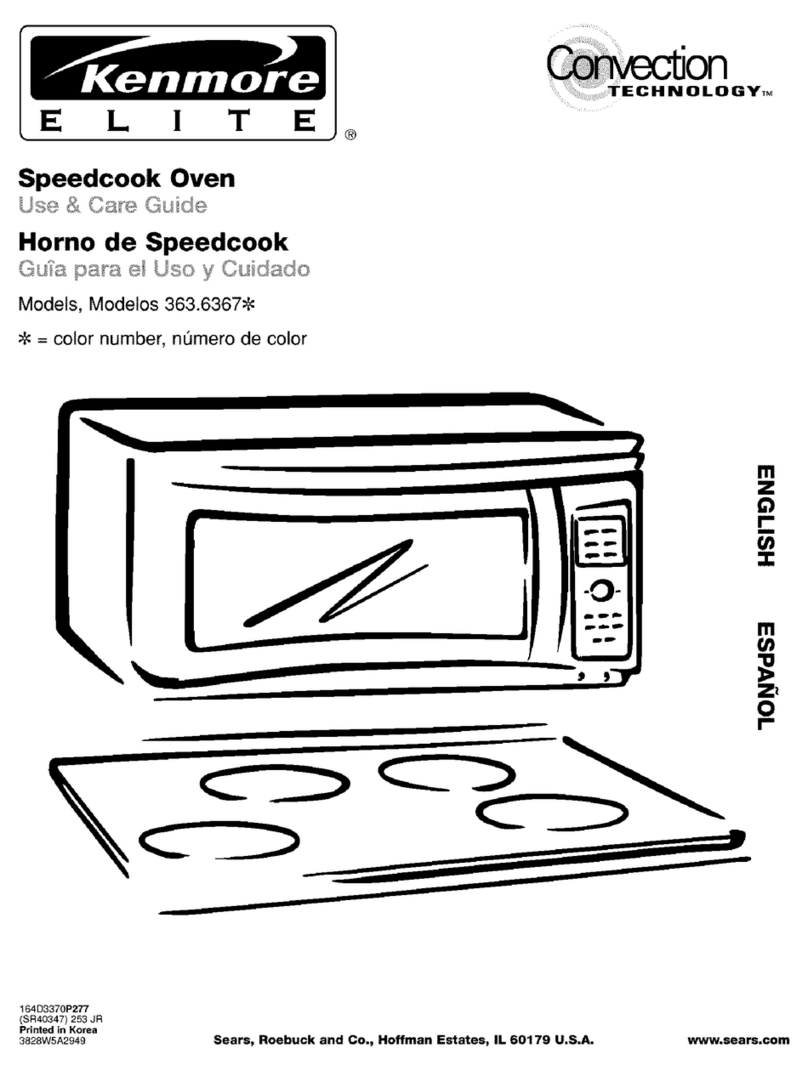
Kenmore
Kenmore 363.6367 Series Use & care guide
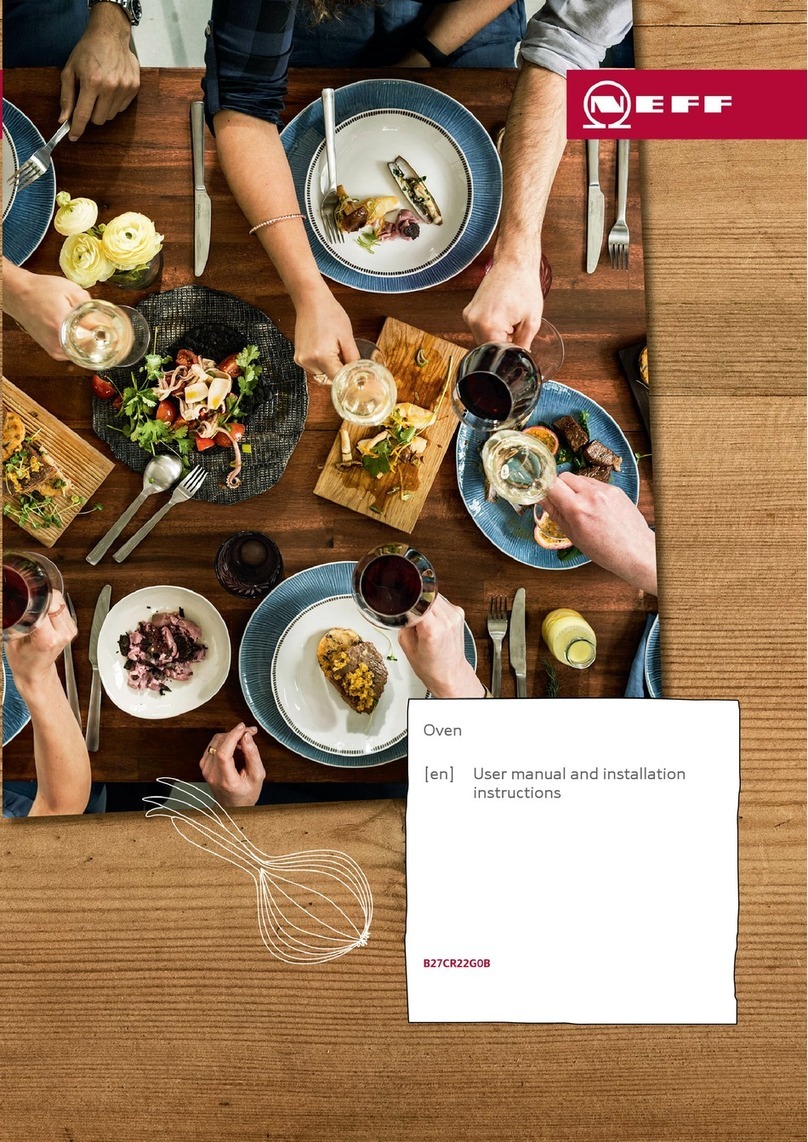
NEFF
NEFF B27CR22G0B User manual and installation instructiions

Fargas
Fargas CBF6S user manual

Hotpoint
Hotpoint MG23N/H Instruction booklet
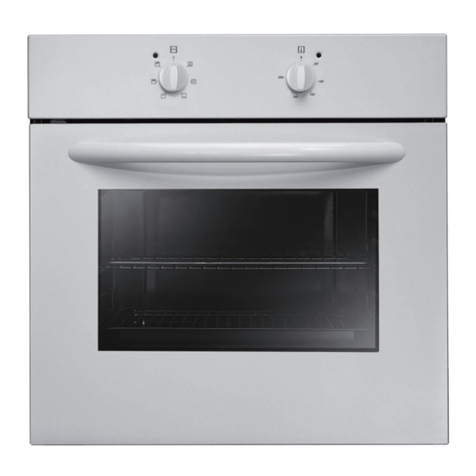
Matsui
Matsui MBCONW10N Instruction & installation manual
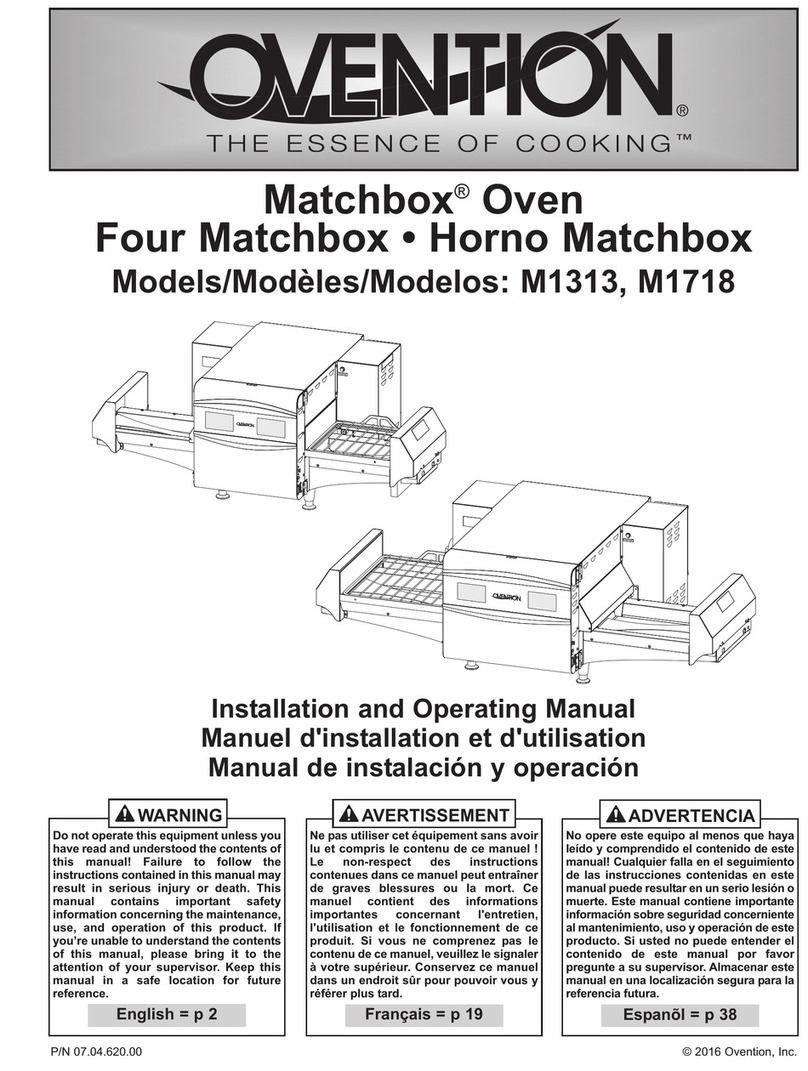
Ovention
Ovention Matchbox M1313 Installation and operating manual

